
a web page by Don Roberson |
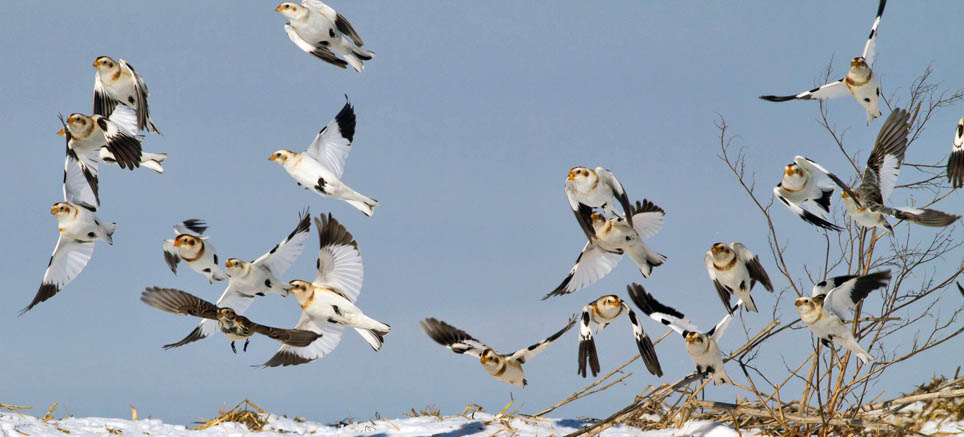 |
LONGSPURS & SNOW BUNTINGS Calcariidae |
||
|
||
Lapland Longspur (below) has a similar distribution, although it does not breed quite as far north as Snow Bunting and it winters a bit farther south. Lapland Longspur is inconspicuous among flocks of larks and pipits in winter, when in muted basic plumage (below left) but brightens considerably through wear as spring approaches (below right, photo by Brian L. Sullivan in California). The remaining 3 longspurs and McKay's Bunting Plectrophenax hyperboreus are restricted to North America (the latter may be just a well-marked race of Snow Bunting). |
||
|
||
In contrast, Smith's Longspur (below) is a long-distance migrant. It breeds at the edge of treeline in the far north from Alaska to Hudson Bay. Singing males in breeding plumage (below right) sport a patterned black-and-white face and a mostly rich buffy body. After breeding, in fall migration and winter, they can be very plain. The wintering grounds are mostly in the southern Great Plains centered around Kansas and Oklahoma. A few strays have been found farther west: his fall vagrant at Moonglow Dairy in Monterey County (below left) represented the first record for California. |
||
|
||
The biology of birds in the Calcariidae is not unlike the many Old World buntings and New World sparrows once combined together as the old Emberizidae (Rising 2011). Longspurs are named for the long claw on the hind toe of each foot. They defend territories by song or song flights over their habitat, and although generally seedeaters, feed insects and other invertebrates to the young in the nest. Are a migratory to wintering grounds; the longspurs all join with Horned Larks, sparrows, or pipits in flocks in short-grass grasslands, pastures, or plowed fields. Recent genetic work (Barker et al. 2013) provided evidence that the Calcariidae diverged from other emberizid relatives about 14 million years ago. Surprisingly, their data suggest that the closest living relative to the longspurs and Snow Buntings is the Rosy Thrush-tanager of the Neotropics, which they also placed in a separate Family [Rhodinocichlidae]. |
||
One of the southernmost ever in California was this individual (left), shown at Pt. Pinos, Monterey Co., where it was photographed over the period 23–26 May 1990. The only other Snow Bunting farther south that spring had been at Ocean Beach, San Diego Co., from 30 Apr–7 May. The unusual dates and locations — very late in spring and very far south — led some to suspect that only a single bird might have been involved. A host of digital photos from both sites permitted the comparison. Pyle & Sullivan (2010) focused on flight-feather-wear patterns and other plumage features to show that this was the same vagrant — some 380 miles [=610 km] apart! |
||
Photos: Murray Lord photographed the flock of Snow Bunting Plectrophenax nivalis [with one Lapland Longspur] east of Ottawa, Ontario, Canada, in Feb 2016. Both Lapland Longspur Calcarius lapponicus were vagrants in Monterey Co., California: the fall bird was in Pacific Grove on 8 Oct 2006, and Brian L. Sullivan photographed the spring vagrant well into breeding plumage near Salinas on 16 Apr 2008. Greg W. Lasley photographed the McCown's Longspur Rhyncophanes mccownii on the breeding grounds at Pawnee Nat'l Grasslands, Colorado, on 7 June 2001. The singing male Smith's Longspur Calcarius pictus was a Churchill, Manitoba, in July 1988; the fall vagrant was at Moonglow Dairy, Moss Landing, California, on 14 Sep 1990. The vagrant Chestnut-collared Longspur C. ornatus was in Pebble Beach, Monterey Co., California, on 23 Oct 2006. The vagrant Snow Bunting was at Pt. Pinos, Monterey Co., on 25 May 2009. Uncredited photos © Don Roberson. Credited photos © Murray Lord, Brian L. Sullivan, and Greg W. Lasley, as credited, and used with permission; all rights reserved. Bibliographic note: There is no "family book" per se but an introduction to this family, with art and photos, is in Rising (2011). The Calcariidae are acknowledged as a Family in the broader text on Emberizidae but preplanned production schedules embedded them here. Literature cited:
|
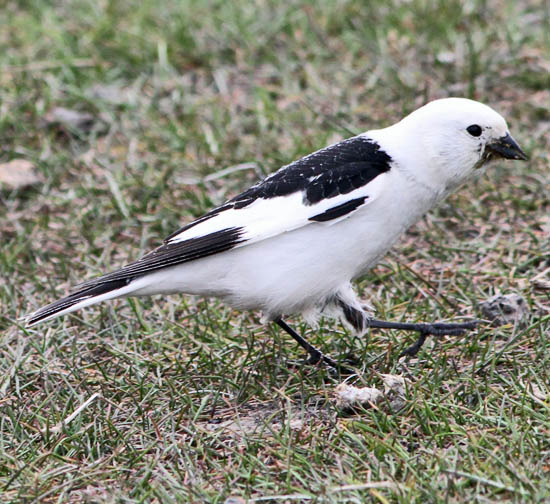 The
Calcariidae as a small family of northern seedeaters. For many years —
until DNA analysis — the six species were considered sparrows embedded
within the larger Emberizidae. Two are circumpolar in the high
latitudes of the northern hemisphere. One is Snow Bunting
(above, a flock of 20 bursts towards the observer in this wonderful
Murray Lord shot; there is a Lapland Longspur among them); a male Snow Bunting
in breeding plumage is shown at left. Snow Bunting breeds in the high
arctic and winters south to north Asia, southern Canada, and the
northern United States.
The
Calcariidae as a small family of northern seedeaters. For many years —
until DNA analysis — the six species were considered sparrows embedded
within the larger Emberizidae. Two are circumpolar in the high
latitudes of the northern hemisphere. One is Snow Bunting
(above, a flock of 20 bursts towards the observer in this wonderful
Murray Lord shot; there is a Lapland Longspur among them); a male Snow Bunting
in breeding plumage is shown at left. Snow Bunting breeds in the high
arctic and winters south to north Asia, southern Canada, and the
northern United States.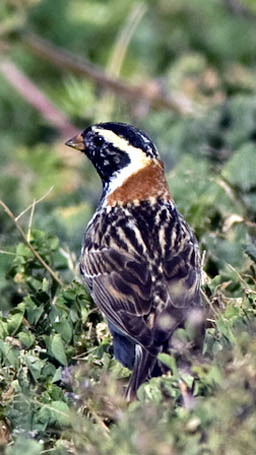
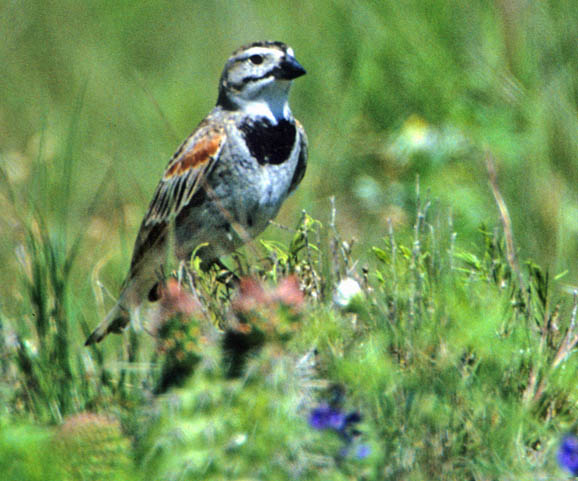 McCown's Longspur
(left in a nice shot by Greg Lasley) breeds in arid short-grass prairie
in the northern Great Plains, from Saskatchewan south to Colorado. It
has a fairly short migration to wintering sites from Arizona to central
Texas. It is well-patterned in summer but in winter, like most
longspurs, is a drab brownish bird best distinguished by tail pattern
and calls.
McCown's Longspur
(left in a nice shot by Greg Lasley) breeds in arid short-grass prairie
in the northern Great Plains, from Saskatchewan south to Colorado. It
has a fairly short migration to wintering sites from Arizona to central
Texas. It is well-patterned in summer but in winter, like most
longspurs, is a drab brownish bird best distinguished by tail pattern
and calls.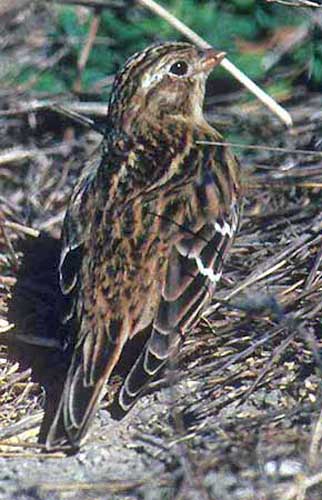

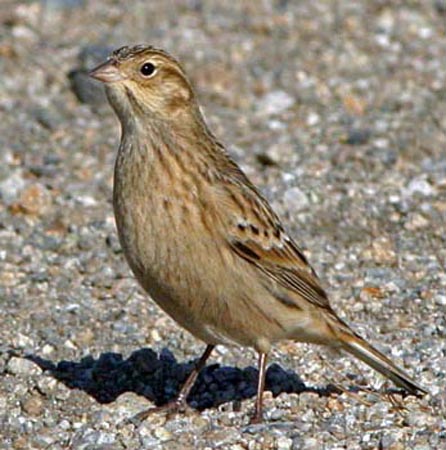 The final longspur is Chestnut-collared Longspur
(right), shown here as a fall vagrant to Monterey Co., California, and
is about as drab as longspurs come in non-breeding plumage. All are
exciting to North American observers because longspurs are migratory
and rarities do turn up.
The final longspur is Chestnut-collared Longspur
(right), shown here as a fall vagrant to Monterey Co., California, and
is about as drab as longspurs come in non-breeding plumage. All are
exciting to North American observers because longspurs are migratory
and rarities do turn up. 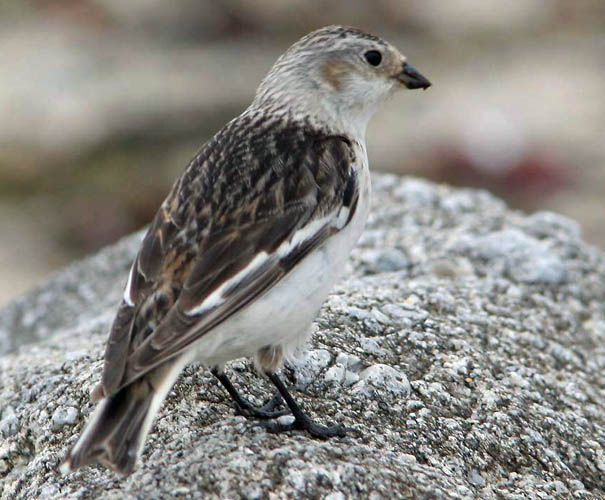 The migration of Snow Bunting
(left) is different than longspurs. Much of the population stays rather
far north in winter, in flocks over a snowy landscape in open country.
Others move towards the coast and winter among sand dunes. Some stray
well south.
The migration of Snow Bunting
(left) is different than longspurs. Much of the population stays rather
far north in winter, in flocks over a snowy landscape in open country.
Others move towards the coast and winter among sand dunes. Some stray
well south.